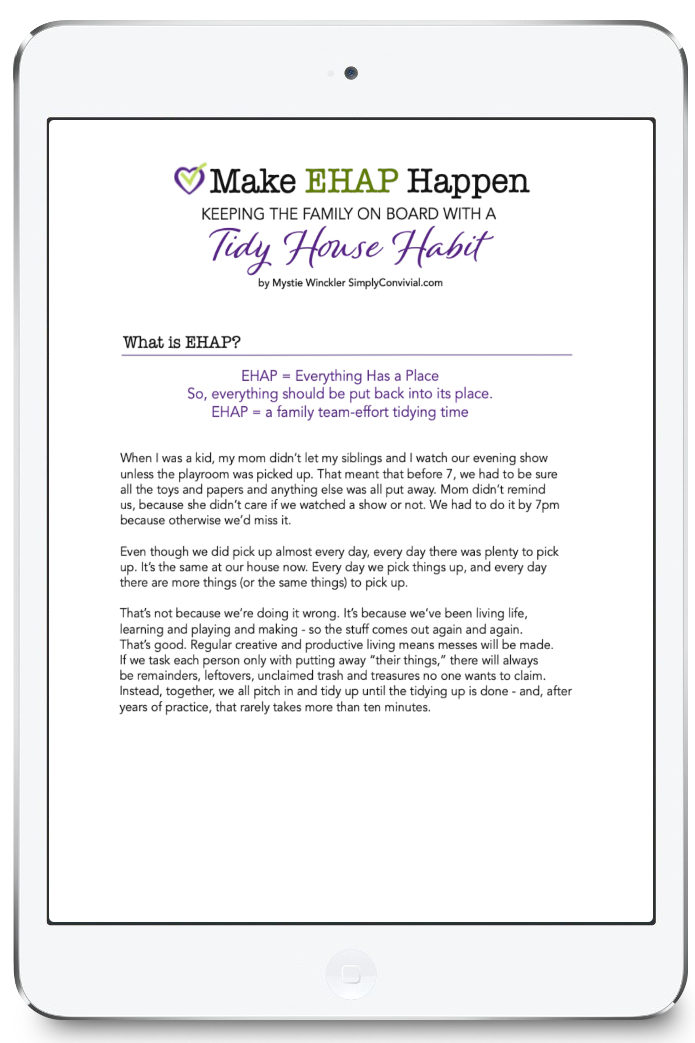
A new kind of kid chore checklist!
Engage kids in chores with fun systems! Use Baby Step Bingo, teamwork, and rewards to make 'kid chores' rewarding & foster responsibility.
Yes, kids should do chores. I've written before about how having chores is good for kids. But assigning chores to kids isn’t just about offloading housework so someone lower on the totem pole does it instead of us. It’s about leading our kids into responsibility alongside us.
That’s a big mission that takes many years to fulfill. However, it doesn’t have to be serious and intense for all those years. In fact, our training efforts will be more effective the more lighthearted and teamwork-oriented we can be.
Some of the ladies inside our homemakers’ continuing education community, Convivial Circle, have set up creative ways to add more teamwork, more chores, and more fun to either weekly or seasonal chore times. I interviewed them to share their stories and how they’ve made a family chore system that doesn’t seem like drudgery.

Anna: Manage Kids’ Chores in a Large Family
First, I had an 18-minute conversation with long-time member Anna Laura Farnham.
Anna and her husband, Gandalf, live in Indiana and have six children ranging from toddler to teenager. Before kids, she earned two music degrees in oboe performance and worked in a corporate office, but she has set aside those careers to focus on being a mom and homemaker.
Making Kids’ Chores a Game
It’s amazing what a boost it is to simply put that chore checklist into a different format. Instead of a long list of things to do, break the chores down into baby steps and put them onto a bingo card.
Anna assigned her kids to tackle small tasks one at a time, like removing cobwebs or wiping down the washing machine. These small steps made a big difference, especially during hectic seasons like pregnancy or postpartum. By going by baby steps instead of projects, kids get to experience a sense of accomplishment as they check off items from their bingo charts.
Anna gave each kid his or her own Bingo Card with chores. Each child’s bingo chart is slightly different, catering to their specific needs and capabilities. This ensures that chores aren’t monotonous and helps keep the kids engaged.
For younger children, like her five-year-old, Anna uses a smaller 4×4 bingo chart and simpler tasks. This approach makes it easier for him to participate and feel involved. While her two-year-old doesn’t have a structured bingo chart, she imitates her older siblings and helps out in small ways, fostering a sense of contribution from a young age.
Anna finds that changing up daily routines with something like Baby Step Bingo can make a big difference. For example, before a holiday or trip, they might include tasks like vacuuming a vehicle or packing clothes in the bingo charts. This adds variety and makes mundane chores exciting.
Anna ensures that the bingo charts include a mix of chores and fun tasks, such as practicing music, memorizing bible verses, or helping siblings.
Rewards for Chores Checklist Completion
Completing bingos translates to rewards like downloading a song, earning candy, or getting a treat like ice cream. These incentives keep the kids motivated.
In addition to the bingo card, Anna uses a chore chart where each child has daily tasks. She then also prints out a weekly chart in the bingo card format and offers rewards to keep it engaging.
While consistency is important, changing things up with Baby Step Bingo or a decluttering challenge adds a layer of fun and helps keep the process fresh.
Anna shares the belief that while kids shouldn’t always need rewards to help with chores, it makes the process more fun and encouraging. This approach teaches them the value of contributing to the family and the satisfaction of a job well done.
At the core, teamwork and a joyful attitude toward homemaking and family life bring about a happier home environment. Whether you’re tackling Baby Step Bingo or working through daily routines, the key is to work together cheerfully and reap the inherent rewards of a well-organized and loving household.
Other Teamwork Chore Charts
Anna also uses slightly gamified techniques, like the Kanban method, during intensive cleaning or preparation for events. Tasks are broken down into manageable pieces and tracked on a board.
Kids can see how tasks move from “to-do” to “done,” which is inherently motivating. In this model, there is only one list and everyone is working together to move all the cards to the DONE column.
Thank you, Anna Laura, for your insights and tips on turning chores into a fun and rewarding activity for the whole family.
Gracie: Motivating Chore Games
Next, I have a 14-minute conversation with mom-of-9, Gracie Madgwick, whose name you will recognize if you’ve read Simplified Organization: Learn to Love What Must Be Done. She’s a featured case study in the book of a mom who took baby steps to reclaim joy in everyday housework.
Gracie grew up a California girl who has been transplanted to the wheat fields of the Midwest. She loves her vocations of daughter of the King of kings, wife to her husband, Stephen, and homeschooling Momma to her nine children. Some of her special treats in life are a good book, a hot cup of tea, and check marks on the to-do list!
What is Baby Step Bingo?
Baby Step Bingo is one of our favorite annual challenges inside Convivial Circle. We use a bingo card filled with small, manageable tasks like “clean the top of your dryer” or “read a psalm or proverb.” The idea is to accomplish these tiny steps, which can collectively make a significant impact.
Although the tasks may seem minor, marking them off on a bingo card helps us recognize and appreciate these small accomplishments. Prizes and the element of fun keep everyone motivated.
You can harness the motivation of a bingo card challenge with my Bust Out of Burnout Bingo freebie!
Play Chore Bingo!
Gracie created specific bingo cards for her children, dividing the tasks based on age and ability. For example, her older boys handled more yard work and larger indoor projects, while her younger children had tasks like decluttering a spot in their room or picking up toys. Each bingo card included a mix of simple and more involved tasks to keep things interesting.
Instead of making cards for each individual like Anna Laura, Gracie made a Boys Card and a Girls Card so the kids each had a team to score points with and also against. This allowed her family to have both cooperation and competition at the same time, while spreading their efforts across a greater amount of work.
Gracie was flexible with the bingo cards, making adjustments as needed. If a task became irrelevant or impractical, she simply replaced it with something more suitable. Her goal was always to keep the activities manageable and rewarding. The family has completed multiple bingo cards, achieving a lot while also getting a break from their regular routines.
Rewards and Kids’ Chores
One unique aspect of Gracie’s Baby Step Bingo is the use of family-oriented prizes. When one of her children completed an entire bingo card, the whole family celebrated with a special treat, fostering teamwork and shared accomplishment.
By focusing on small steps, Gracie tackled larger projects over time. This method not only kept their home organized but also provided the children with a sense of accomplishment.
Creative Kids’ Chore Checklists
By focusing on small steps, Gracie managed to tackle larger projects over time, such as organizing spaces that often went unnoticed. This method not only kept their home more organized but also provided the children with a sense of accomplishment.
Gracie’s experience with Baby Step Bingo shows how small, manageable tasks can add up to significant achievements. By incorporating fun, flexibility, and family-oriented rewards, she turned routine chores into opportunities for productivity and joy.
Whether you’re looking for ways to keep your kids engaged during a break or just want a structured method to tackle household tasks, consider giving Baby Step Bingo a try. It’s a simple yet powerful tool for bringing order and happiness to your home.
Want a Tidier House?
- Get clear on when your family needs to tidy up.
- Bring the kids on board to take responsibility for tidying more than their own stuff.
- Learn the three steps to make the habit stick for the long haul.






